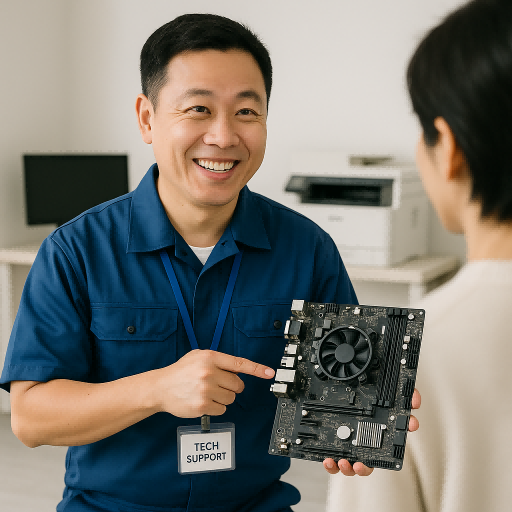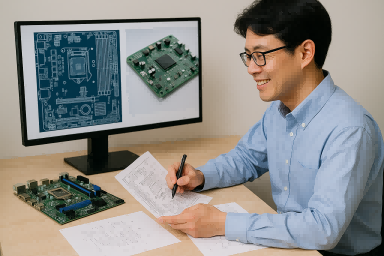Support That Lasts Beyond Delivery

Support Levels That Scale With Your Needs
Whether you’re facing BIOS configuration issues, signal interference, or need integration guidance—our support channels are built for engineers who need answers, not delays.
Email Support
Direct access to our hardware and BIOS engineers.
Phone Consultation (For OEMs)
Scheduled support sessions for project-specific needs or urgent issues.
Self-Service Resources
Access our Knowledge Center: whitepapers, specs, FAQs, and case studies.
Ticket-Based Priority Support
Submit an issue with severity level, logs, and device info.
Get structured follow-up and resolution timelines.
RMA & Warranty Services
Reliable Warranty. Clear RMA Process
We back our products with straightforward warranty coverage and a transparent RMA flow to minimize your downtime and simplify issue resolution.
Warranty Overview
| Item | Details |
|---|---|
| Standard Warranty | 1-year limited coverage from shipment date |
| OEM Extended Warranty | Optional 3-year support for long lifecycle projects |
| What’s Covered | Manufacturing defects, hardware failure under normal operating conditions |
| What’s Not Covered | Physical damage, misuse, third-party mods, improper installation or handling |
RMA Workflow
| Step | Action |
|---|---|
| 1 | Contact support with issue details, logs, and serial number |
| 2 | Receive RMA authorization and return label |
| 3 | Ship product to our RMA center (customer pays outbound) |
| 4 | Repair or replace unit (usually 7–15 business days) |
| 5 | Return shipment (For hardware-related issues confirmed under warranty, we will cover the return shipping costs. For non-quality-related returns, customers are responsible for the return shipping.) |

Need Support? We’re Here to Help
Whether it’s troubleshooting, replacement coordination, or lifecycle advice—our team is ready to assist. Tell us what you need, and we’ll connect you with the right expert.
Lifecycle & EOL Support
Built for the Long Run—Plan with Confidence
We understand the cost of sudden changes in hardware. That’s why we provide clear, proactive lifecycle management—including early EOL notices, replacement planning, and extended availability options for key projects.
Product Lifecycle Planning
Clear roadmap visibility for all standard SKUs, including longevity forecasts
Replacement Guidance
Compatible model suggestions with BIOS/connector continuity
EOL Notification Lead Time
Minimum 6–12 months advance notice before End-of-Life transition
Firmware Image Lock Support
Maintain consistent BIOS/firmware versionsOS image integrity across batches
Last Time Buy (LTB) Options
Secure final batch purchases with locked BOM and firmware
Extended Supply Programs
Optional multi-year stocking or production extensions (for OEM partners)
Tailored Support for OEM Demands
Beyond standard support, we offer a range of custom services to meet the specific requirements of your hardware deployment—whether you’re building thousands of kiosks, integrating into robotics, or certifying for medical use.
OEM-Centric Service Options


Quick Answers to Common Support Questions
Get instant clarity on return policies, support channels, warranty terms, and custom service options—all in one place.
How do I submit a support request?
Use our online form or email info@miniitxboard.com. Include your product serial number and a brief issue description.
What’s your standard RMA turnaround time?
Typically 7–15 business days from receipt of product, depending on issue severity and stock.
Can I request BIOS customization after delivery?
Yes. However, post-shipment customization may require remote assistance or on-site programming tools.
How far in advance do you notify about EOL products?
We provide a minimum of 6–12 months notice, along with replacement guidance and last-buy options.
Related Blog Insights
From field failure diagnostics to BIOS rollback strategies, our blog covers real-world support stories and embedded reliability best practices.
Intel Celeron N150: Balancing Power, Performance, and Practical Efficiency in Compact Systems
Table of Contents 1. Introduction: The Role of the N150 in Modern Embedded Platforms 2. CPU Microarchitecture and Platform Integration 3. Thermal Design and Power Consumption in Real Deployments 4.…
Intel Celeron N300: Engineering Low-Power Performance for Modern Embedded Systems
Table of Contents Introduction: The N300’s Place in Embedded and SFF Markets Architecture & SoC Integration Power Consumption & Idle Realities BIOS & Tuning for Sustained Performance Thermal Performance &…
